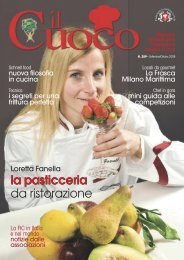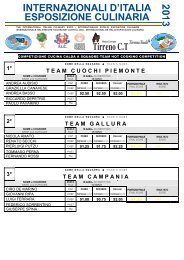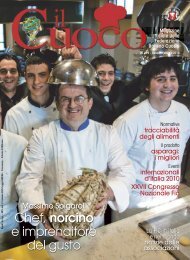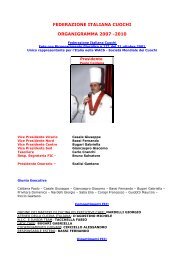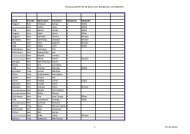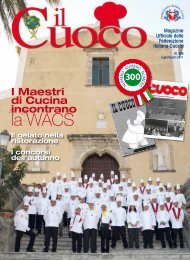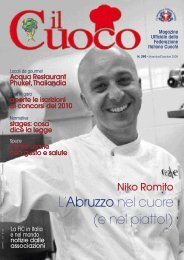Scarica versione PDF - Federazione Italiana Cuochi
Scarica versione PDF - Federazione Italiana Cuochi
Scarica versione PDF - Federazione Italiana Cuochi
You also want an ePaper? Increase the reach of your titles
YUMPU automatically turns print PDFs into web optimized ePapers that Google loves.
if according to some writers it is morecorrect to attribute the etymon to theterm proexsucatus (i.e. prosciugato(dried)). Already from the etymologicalobservation we can see the fundamentalcharacteristic of the ham, i.e. the dryingof meats, both natural (by drying due toexposure to the air) and induced withsalting or possibly smoking.The term was found starting from theXIV century indiscriminately in the twoforms, but the product designed in thisway was well known and appreciatedboth by the Greeks and the Romans. Accordingto some archaeological evidence(the remains of bones in Neolithic bedsof the V Millennium) it appears that theleg of wild pigs caught in the hills by ourancestors during the cave period was p-reserved by smoking even if not for excessivelylong periods.FROM THE LEGOR THE SHOULDERThe pig reared by man for at least 14 t-housand years, is without a doubt one ofthe most useful domestic four-footed animals,because unlike others it costsvery little to keep. In a certain sense, itmanages on its own, usually eating theleftovers and waste of other animalsand man’s kitchen. Hippocrates indicatedpork as the most nourishing meat, butat the same time recommended the animalshould not be fat, thin, young orold, but well-fed and properly bled. TheRomans distinguished with the term“perno” the ham made with the leg (andagain the Spanish language called thesame anatomical part of the pig “perna”)and with “petaso” ham made with theshoulder (pettola or petasola is in Irpiniaand in other areas of the South the ancientname for the anatomical part of thepig from which the shoulder is separated).In the de re rustica, Cato (III-II centuryB.C.) was the first to describe the correctprocedure for making ham and alsothe Latin Varrone and Columella discussedthe topic with great enthusiasm.Starting from the Fourteenth century, a-gricultural literature – which was notwritten to be read by the peasants but bythe land owners – spoke regularly of updatingthe “swineherds” about the mostsuitable techniques for preserving hamsfrom both the leg and the shoulder well.Many of these suggestions and recommendationsare still valid today and areindispensable for valorising the sensorialaspects of the meats. Starting from thesuggestions about the best way of rearingpigs: from diet to recommendationsabout a homogeneous and gradual fattening,from the exclusion of certain animalsfrom dressing and salting (for examplethe boar), to the best season forbutchering and the best months formaking excellent salamis and charcuterie.EXCELLENTIN THE MOUNTAINSAll authors agree on the fact that themountains and hills are most suitable environmentfor rearing ham pigs (this alsoapplies for pigs and boar). The humid,warm valley lands of the plains do nothave the right characteristics for transmittinggreat organoleptic and nutritionalvalues to hams. This doesn’t meanthat hams “from the plains” are notworthy of the gourmet’s attention. Parma,for example, gives us a veritablemasterpiece in pork art which is perhapsone of the most famous hams in theworld. Its vocation derives from the factthat it is situated in an area which is partiallyfull of valleys but also rich in dairyfarms(Parmesan cheese) whose wasteproducts from cheese producing aresent to feed large herds of pigs. Technology,where special micro-climates asin the mountains and the hills are notavailable, arrives in aid of cheese producersproviding them with sophisticatedmaturing cells which exactly copy thetemperature and humidity conditionstypical of the mountain areas.Put if we look at the map of the most famousraw hams in our country we realisethat the origin is always and inevitablylinked to the mountains: from SanDaniele del Friuli to Sauris, from Norciain Umbria to the Tuscany Casentinoarea,fromUpperIrpiniatoBossesinvalled’aosta, it is an anthology of gastronomic“pearls” making us the envy of the wholeworld.Ham is therefore synonymous with themountains, because far from the plains,pigs not forced to live in high density stysor enclosures live better, give less stressedmeat, have the possibility of feeding inthe most natural manner, have physicalexercise finding food and certainly acquirea firmer, less fat muscular system.The mountains also have the best climaticsituations for processing theABBONATI SUBITOACUCINAGOURMETil nuovo mensilee di ricette,ristoranti, viaggi,vini e sapori12 MESI + 6 INOMAGGIOA SOLI255 EUROANZICHÉ É72________________________________OFFERTA RISERVATAAI SOCI DELLA F.I.C.-VALIDA SOLOO IN ITALIA -Inviare Fax al numero 0376 296023e/o E-mail aabbonamenti@edifim.itamenti@edifim.itallegando copia del pagamentoSì,desidero abbonarmi aCUCINA GOURMETNome……………………………………….…………….........…………….…………….........…Cognome.............…......………..........................................................................................Indirizzo……………………….................................................CAP.........................Loc.…………….........................Pr..…...……….........................Pr..…...Tel………………....................…………....................................………....................................E-mail…………...…………..................................................…..........................................…C.F. / P.iva.………...............…................………….....................………….....SCELGO LA SEGUENTE FORMA DI PAGAMENTO: Firma




